Waste Plastic in Bituminous Road Construction Project Proposal
VerifiedAdded on 2023/06/03
|12
|3235
|408
Project
AI Summary
This project proposal explores the utilization of waste plastic in bituminous road construction, addressing environmental concerns and infrastructure challenges. The study includes a literature review, research questions focusing on bitumen reduction and plastic waste percentage, and objectives related to soil testing, pavement design, and plastic incorporation. The methodology involves secondary data analysis of aggregate and bitumen testing methods. The project plan outlines tasks, timelines, and resource allocation for research, analysis, and report development. The aim is to eradicate potholes, increase road lifespan, and control pollution through sustainable road construction practices. Desklib offers a wide array of similar project reports and solved assignments for students.
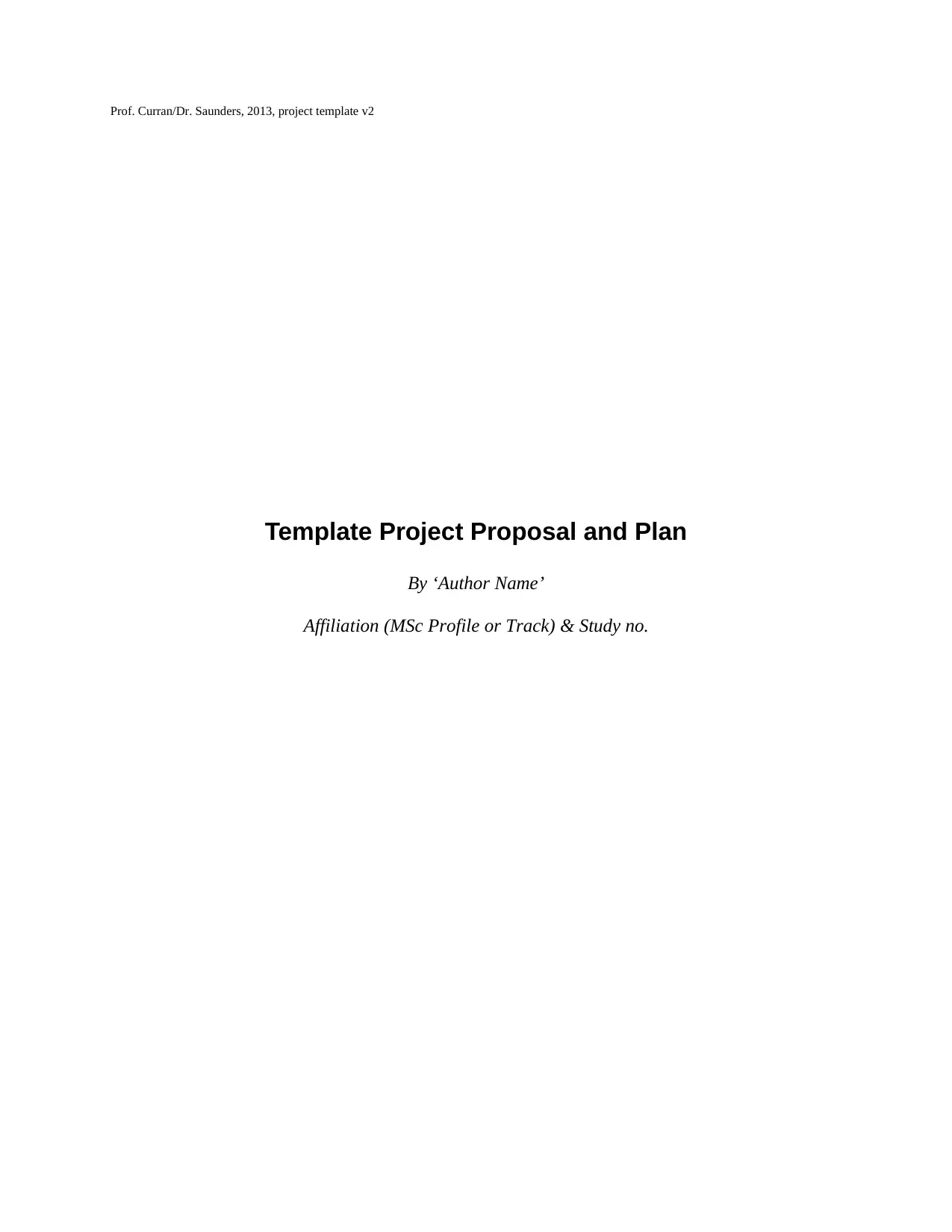
Prof. Curran/Dr. Saunders, 2013, project template v2
Template Project Proposal and Plan
By ‘Author Name’
Affiliation (MSc Profile or Track) & Study no.
Template Project Proposal and Plan
By ‘Author Name’
Affiliation (MSc Profile or Track) & Study no.
Paraphrase This Document
Need a fresh take? Get an instant paraphrase of this document with our AI Paraphraser
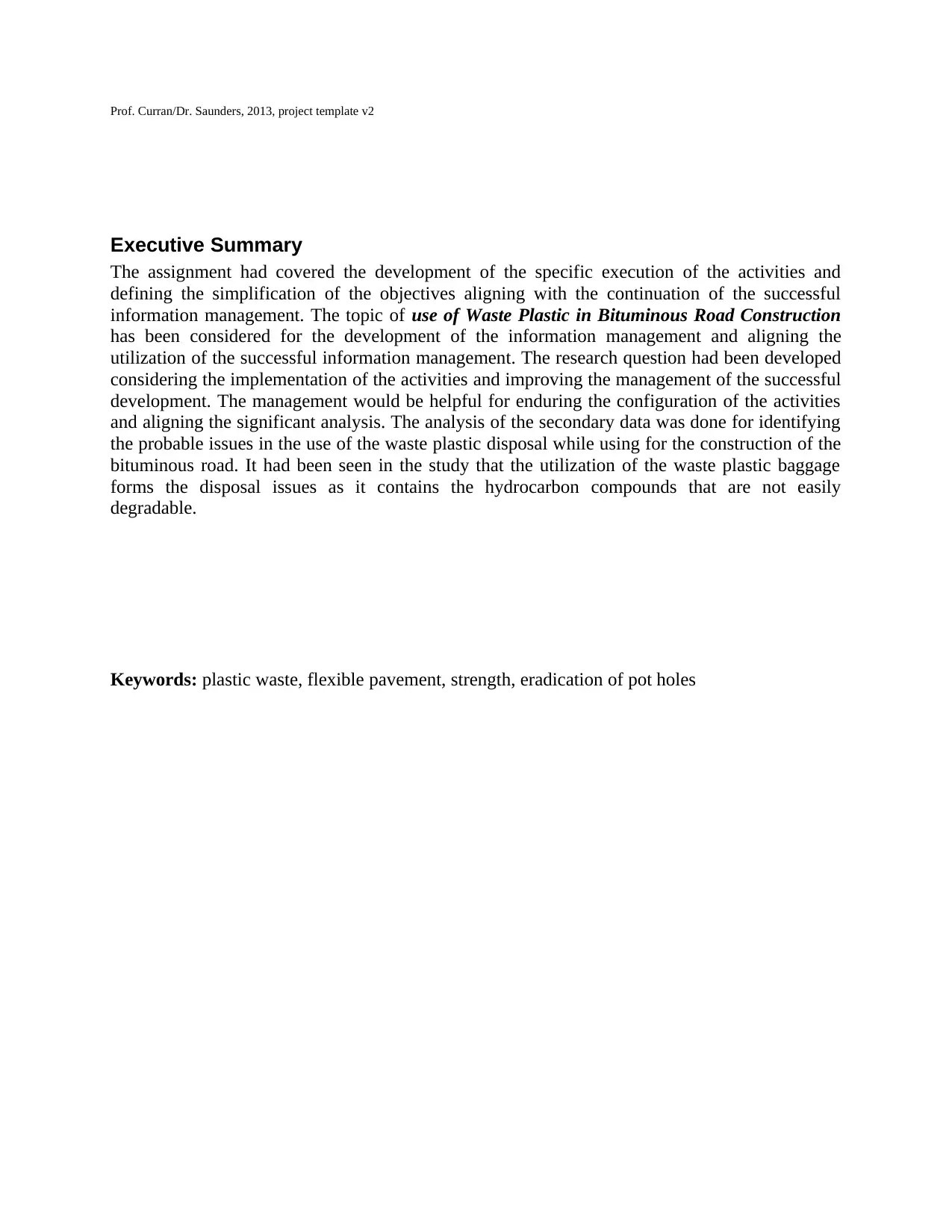
Prof. Curran/Dr. Saunders, 2013, project template v2
Executive Summary
The assignment had covered the development of the specific execution of the activities and
defining the simplification of the objectives aligning with the continuation of the successful
information management. The topic of use of Waste Plastic in Bituminous Road Construction
has been considered for the development of the information management and aligning the
utilization of the successful information management. The research question had been developed
considering the implementation of the activities and improving the management of the successful
development. The management would be helpful for enduring the configuration of the activities
and aligning the significant analysis. The analysis of the secondary data was done for identifying
the probable issues in the use of the waste plastic disposal while using for the construction of the
bituminous road. It had been seen in the study that the utilization of the waste plastic baggage
forms the disposal issues as it contains the hydrocarbon compounds that are not easily
degradable.
Keywords: plastic waste, flexible pavement, strength, eradication of pot holes
Executive Summary
The assignment had covered the development of the specific execution of the activities and
defining the simplification of the objectives aligning with the continuation of the successful
information management. The topic of use of Waste Plastic in Bituminous Road Construction
has been considered for the development of the information management and aligning the
utilization of the successful information management. The research question had been developed
considering the implementation of the activities and improving the management of the successful
development. The management would be helpful for enduring the configuration of the activities
and aligning the significant analysis. The analysis of the secondary data was done for identifying
the probable issues in the use of the waste plastic disposal while using for the construction of the
bituminous road. It had been seen in the study that the utilization of the waste plastic baggage
forms the disposal issues as it contains the hydrocarbon compounds that are not easily
degradable.
Keywords: plastic waste, flexible pavement, strength, eradication of pot holes
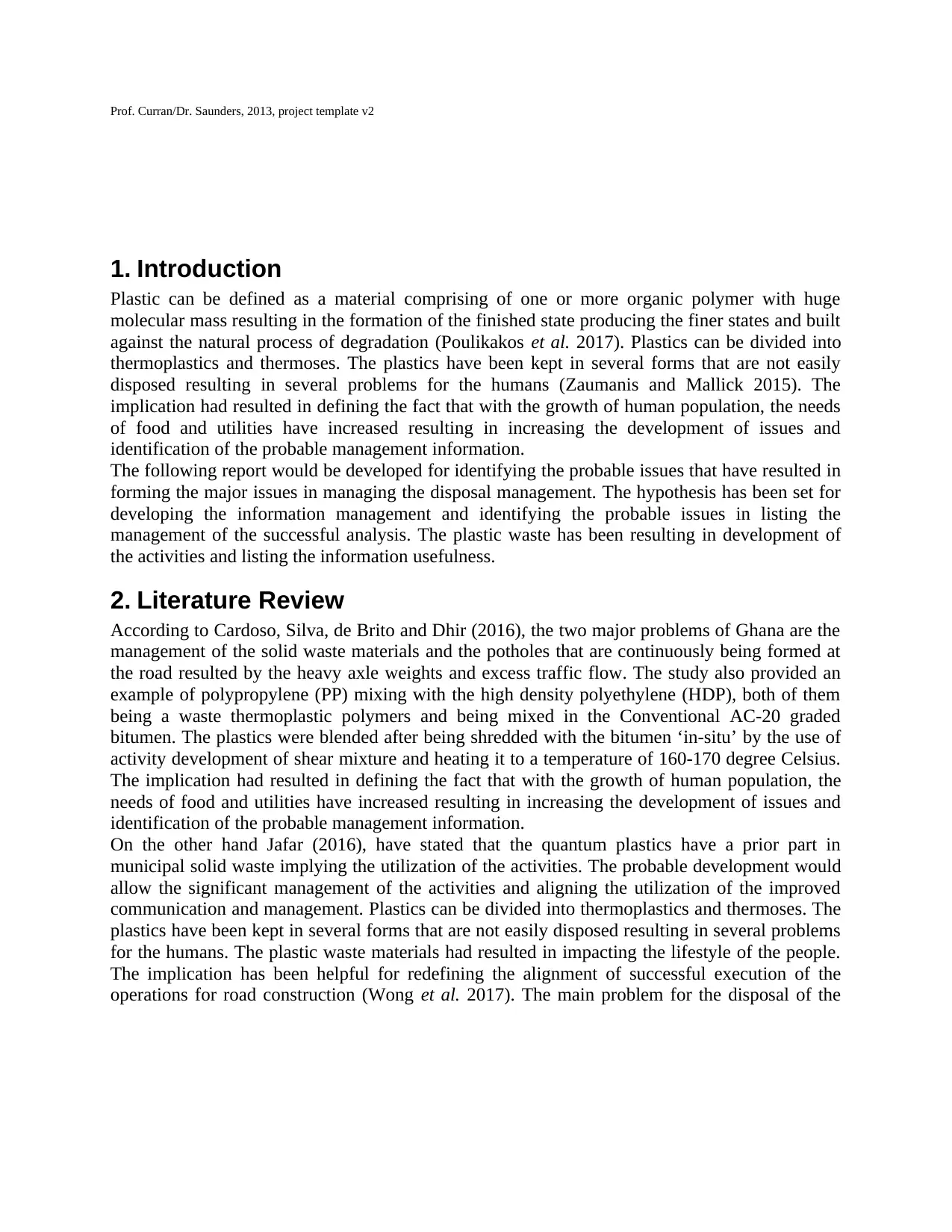
Prof. Curran/Dr. Saunders, 2013, project template v2
1. Introduction
Plastic can be defined as a material comprising of one or more organic polymer with huge
molecular mass resulting in the formation of the finished state producing the finer states and built
against the natural process of degradation (Poulikakos et al. 2017). Plastics can be divided into
thermoplastics and thermoses. The plastics have been kept in several forms that are not easily
disposed resulting in several problems for the humans (Zaumanis and Mallick 2015). The
implication had resulted in defining the fact that with the growth of human population, the needs
of food and utilities have increased resulting in increasing the development of issues and
identification of the probable management information.
The following report would be developed for identifying the probable issues that have resulted in
forming the major issues in managing the disposal management. The hypothesis has been set for
developing the information management and identifying the probable issues in listing the
management of the successful analysis. The plastic waste has been resulting in development of
the activities and listing the information usefulness.
2. Literature Review
According to Cardoso, Silva, de Brito and Dhir (2016), the two major problems of Ghana are the
management of the solid waste materials and the potholes that are continuously being formed at
the road resulted by the heavy axle weights and excess traffic flow. The study also provided an
example of polypropylene (PP) mixing with the high density polyethylene (HDP), both of them
being a waste thermoplastic polymers and being mixed in the Conventional AC-20 graded
bitumen. The plastics were blended after being shredded with the bitumen ‘in-situ’ by the use of
activity development of shear mixture and heating it to a temperature of 160-170 degree Celsius.
The implication had resulted in defining the fact that with the growth of human population, the
needs of food and utilities have increased resulting in increasing the development of issues and
identification of the probable management information.
On the other hand Jafar (2016), have stated that the quantum plastics have a prior part in
municipal solid waste implying the utilization of the activities. The probable development would
allow the significant management of the activities and aligning the utilization of the improved
communication and management. Plastics can be divided into thermoplastics and thermoses. The
plastics have been kept in several forms that are not easily disposed resulting in several problems
for the humans. The plastic waste materials had resulted in impacting the lifestyle of the people.
The implication has been helpful for redefining the alignment of successful execution of the
operations for road construction (Wong et al. 2017). The main problem for the disposal of the
1. Introduction
Plastic can be defined as a material comprising of one or more organic polymer with huge
molecular mass resulting in the formation of the finished state producing the finer states and built
against the natural process of degradation (Poulikakos et al. 2017). Plastics can be divided into
thermoplastics and thermoses. The plastics have been kept in several forms that are not easily
disposed resulting in several problems for the humans (Zaumanis and Mallick 2015). The
implication had resulted in defining the fact that with the growth of human population, the needs
of food and utilities have increased resulting in increasing the development of issues and
identification of the probable management information.
The following report would be developed for identifying the probable issues that have resulted in
forming the major issues in managing the disposal management. The hypothesis has been set for
developing the information management and identifying the probable issues in listing the
management of the successful analysis. The plastic waste has been resulting in development of
the activities and listing the information usefulness.
2. Literature Review
According to Cardoso, Silva, de Brito and Dhir (2016), the two major problems of Ghana are the
management of the solid waste materials and the potholes that are continuously being formed at
the road resulted by the heavy axle weights and excess traffic flow. The study also provided an
example of polypropylene (PP) mixing with the high density polyethylene (HDP), both of them
being a waste thermoplastic polymers and being mixed in the Conventional AC-20 graded
bitumen. The plastics were blended after being shredded with the bitumen ‘in-situ’ by the use of
activity development of shear mixture and heating it to a temperature of 160-170 degree Celsius.
The implication had resulted in defining the fact that with the growth of human population, the
needs of food and utilities have increased resulting in increasing the development of issues and
identification of the probable management information.
On the other hand Jafar (2016), have stated that the quantum plastics have a prior part in
municipal solid waste implying the utilization of the activities. The probable development would
allow the significant management of the activities and aligning the utilization of the improved
communication and management. Plastics can be divided into thermoplastics and thermoses. The
plastics have been kept in several forms that are not easily disposed resulting in several problems
for the humans. The plastic waste materials had resulted in impacting the lifestyle of the people.
The implication has been helpful for redefining the alignment of successful execution of the
operations for road construction (Wong et al. 2017). The main problem for the disposal of the
⊘ This is a preview!⊘
Do you want full access?
Subscribe today to unlock all pages.

Trusted by 1+ million students worldwide
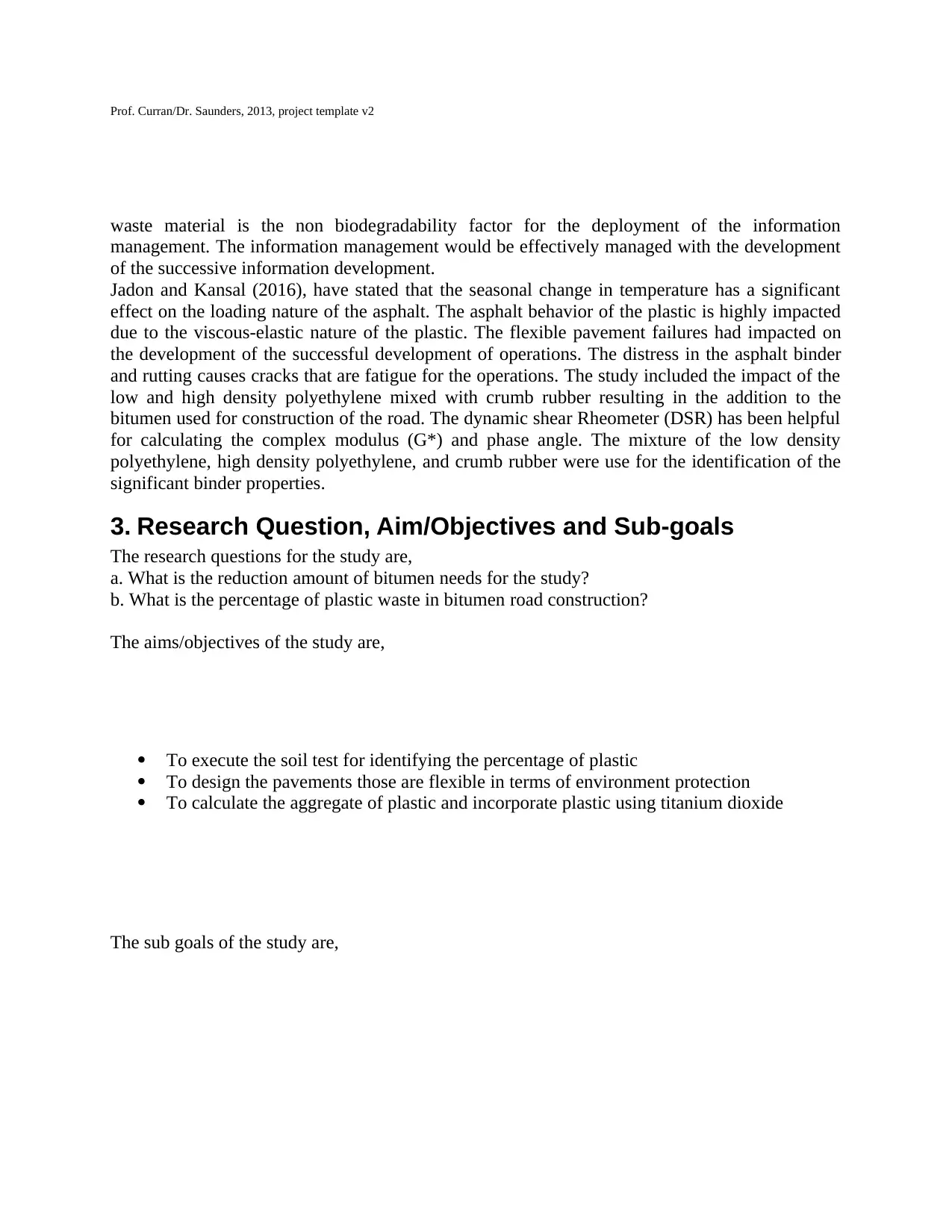
Prof. Curran/Dr. Saunders, 2013, project template v2
waste material is the non biodegradability factor for the deployment of the information
management. The information management would be effectively managed with the development
of the successive information development.
Jadon and Kansal (2016), have stated that the seasonal change in temperature has a significant
effect on the loading nature of the asphalt. The asphalt behavior of the plastic is highly impacted
due to the viscous-elastic nature of the plastic. The flexible pavement failures had impacted on
the development of the successful development of operations. The distress in the asphalt binder
and rutting causes cracks that are fatigue for the operations. The study included the impact of the
low and high density polyethylene mixed with crumb rubber resulting in the addition to the
bitumen used for construction of the road. The dynamic shear Rheometer (DSR) has been helpful
for calculating the complex modulus (G*) and phase angle. The mixture of the low density
polyethylene, high density polyethylene, and crumb rubber were use for the identification of the
significant binder properties.
3. Research Question, Aim/Objectives and Sub-goals
The research questions for the study are,
a. What is the reduction amount of bitumen needs for the study?
b. What is the percentage of plastic waste in bitumen road construction?
The aims/objectives of the study are,
To execute the soil test for identifying the percentage of plastic
To design the pavements those are flexible in terms of environment protection
To calculate the aggregate of plastic and incorporate plastic using titanium dioxide
The sub goals of the study are,
waste material is the non biodegradability factor for the deployment of the information
management. The information management would be effectively managed with the development
of the successive information development.
Jadon and Kansal (2016), have stated that the seasonal change in temperature has a significant
effect on the loading nature of the asphalt. The asphalt behavior of the plastic is highly impacted
due to the viscous-elastic nature of the plastic. The flexible pavement failures had impacted on
the development of the successful development of operations. The distress in the asphalt binder
and rutting causes cracks that are fatigue for the operations. The study included the impact of the
low and high density polyethylene mixed with crumb rubber resulting in the addition to the
bitumen used for construction of the road. The dynamic shear Rheometer (DSR) has been helpful
for calculating the complex modulus (G*) and phase angle. The mixture of the low density
polyethylene, high density polyethylene, and crumb rubber were use for the identification of the
significant binder properties.
3. Research Question, Aim/Objectives and Sub-goals
The research questions for the study are,
a. What is the reduction amount of bitumen needs for the study?
b. What is the percentage of plastic waste in bitumen road construction?
The aims/objectives of the study are,
To execute the soil test for identifying the percentage of plastic
To design the pavements those are flexible in terms of environment protection
To calculate the aggregate of plastic and incorporate plastic using titanium dioxide
The sub goals of the study are,
Paraphrase This Document
Need a fresh take? Get an instant paraphrase of this document with our AI Paraphraser
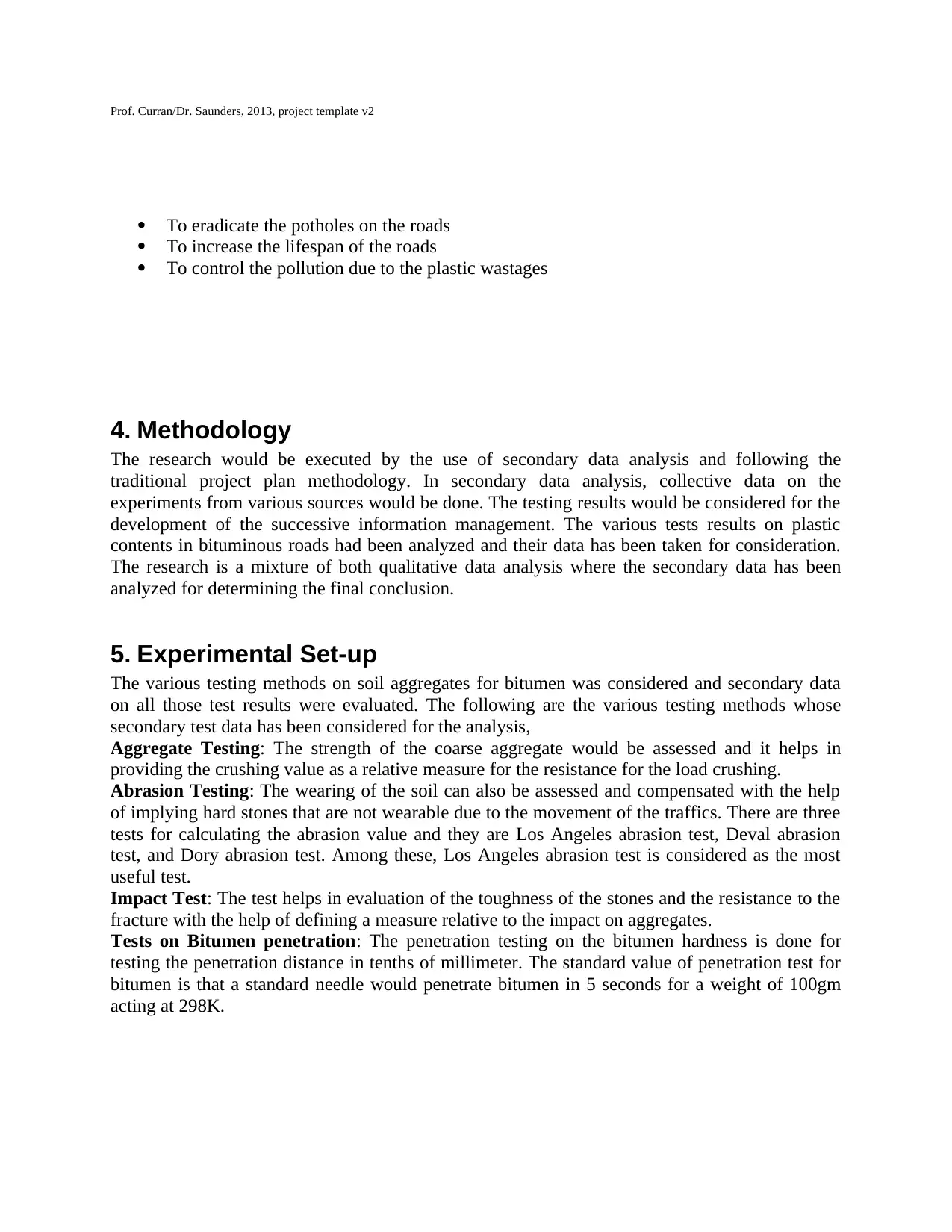
Prof. Curran/Dr. Saunders, 2013, project template v2
To eradicate the potholes on the roads
To increase the lifespan of the roads
To control the pollution due to the plastic wastages
4. Methodology
The research would be executed by the use of secondary data analysis and following the
traditional project plan methodology. In secondary data analysis, collective data on the
experiments from various sources would be done. The testing results would be considered for the
development of the successive information management. The various tests results on plastic
contents in bituminous roads had been analyzed and their data has been taken for consideration.
The research is a mixture of both qualitative data analysis where the secondary data has been
analyzed for determining the final conclusion.
5. Experimental Set-up
The various testing methods on soil aggregates for bitumen was considered and secondary data
on all those test results were evaluated. The following are the various testing methods whose
secondary test data has been considered for the analysis,
Aggregate Testing: The strength of the coarse aggregate would be assessed and it helps in
providing the crushing value as a relative measure for the resistance for the load crushing.
Abrasion Testing: The wearing of the soil can also be assessed and compensated with the help
of implying hard stones that are not wearable due to the movement of the traffics. There are three
tests for calculating the abrasion value and they are Los Angeles abrasion test, Deval abrasion
test, and Dory abrasion test. Among these, Los Angeles abrasion test is considered as the most
useful test.
Impact Test: The test helps in evaluation of the toughness of the stones and the resistance to the
fracture with the help of defining a measure relative to the impact on aggregates.
Tests on Bitumen penetration: The penetration testing on the bitumen hardness is done for
testing the penetration distance in tenths of millimeter. The standard value of penetration test for
bitumen is that a standard needle would penetrate bitumen in 5 seconds for a weight of 100gm
acting at 298K.
To eradicate the potholes on the roads
To increase the lifespan of the roads
To control the pollution due to the plastic wastages
4. Methodology
The research would be executed by the use of secondary data analysis and following the
traditional project plan methodology. In secondary data analysis, collective data on the
experiments from various sources would be done. The testing results would be considered for the
development of the successive information management. The various tests results on plastic
contents in bituminous roads had been analyzed and their data has been taken for consideration.
The research is a mixture of both qualitative data analysis where the secondary data has been
analyzed for determining the final conclusion.
5. Experimental Set-up
The various testing methods on soil aggregates for bitumen was considered and secondary data
on all those test results were evaluated. The following are the various testing methods whose
secondary test data has been considered for the analysis,
Aggregate Testing: The strength of the coarse aggregate would be assessed and it helps in
providing the crushing value as a relative measure for the resistance for the load crushing.
Abrasion Testing: The wearing of the soil can also be assessed and compensated with the help
of implying hard stones that are not wearable due to the movement of the traffics. There are three
tests for calculating the abrasion value and they are Los Angeles abrasion test, Deval abrasion
test, and Dory abrasion test. Among these, Los Angeles abrasion test is considered as the most
useful test.
Impact Test: The test helps in evaluation of the toughness of the stones and the resistance to the
fracture with the help of defining a measure relative to the impact on aggregates.
Tests on Bitumen penetration: The penetration testing on the bitumen hardness is done for
testing the penetration distance in tenths of millimeter. The standard value of penetration test for
bitumen is that a standard needle would penetrate bitumen in 5 seconds for a weight of 100gm
acting at 298K.
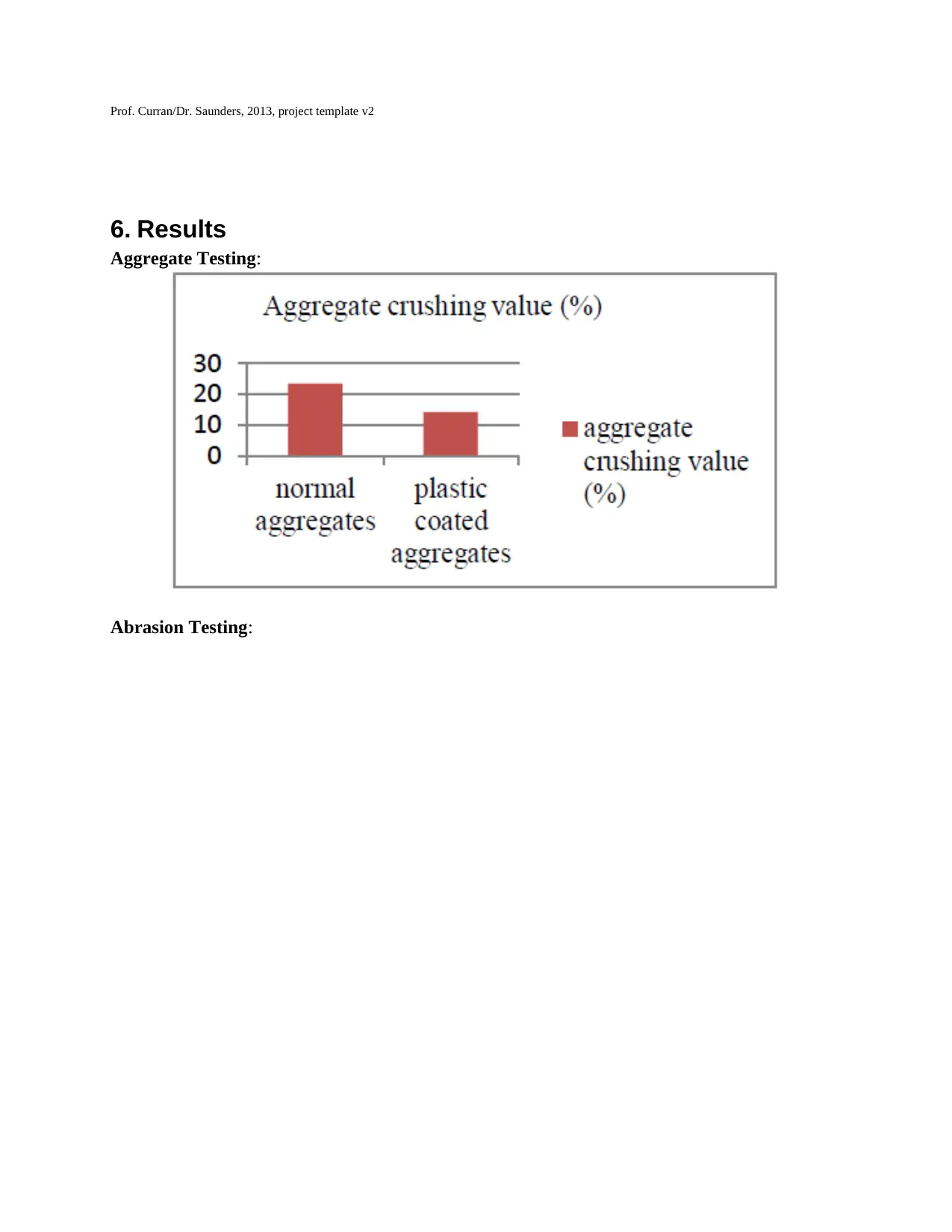
Prof. Curran/Dr. Saunders, 2013, project template v2
6. Results
Aggregate Testing:
Abrasion Testing:
6. Results
Aggregate Testing:
Abrasion Testing:
⊘ This is a preview!⊘
Do you want full access?
Subscribe today to unlock all pages.

Trusted by 1+ million students worldwide
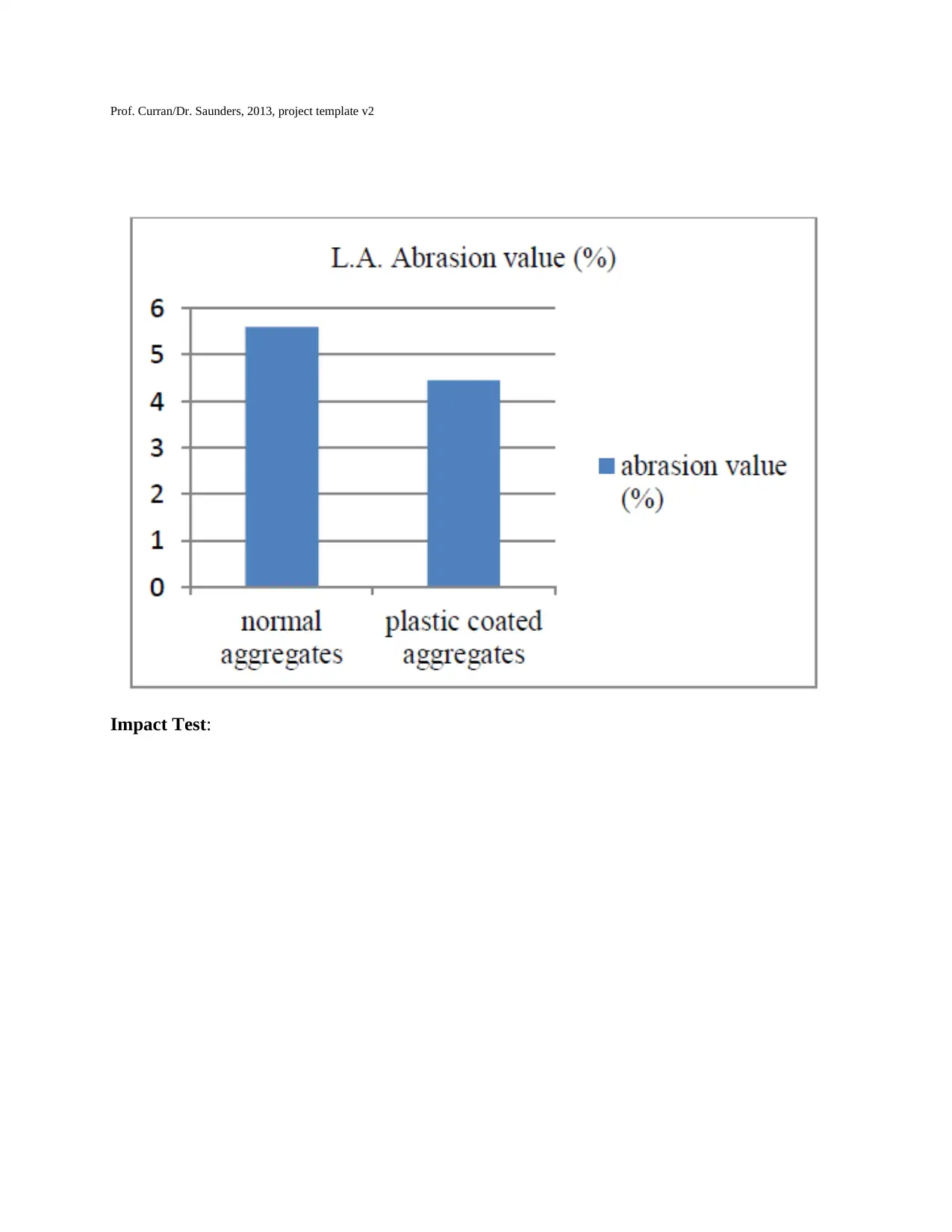
Prof. Curran/Dr. Saunders, 2013, project template v2
Impact Test:
Impact Test:
Paraphrase This Document
Need a fresh take? Get an instant paraphrase of this document with our AI Paraphraser
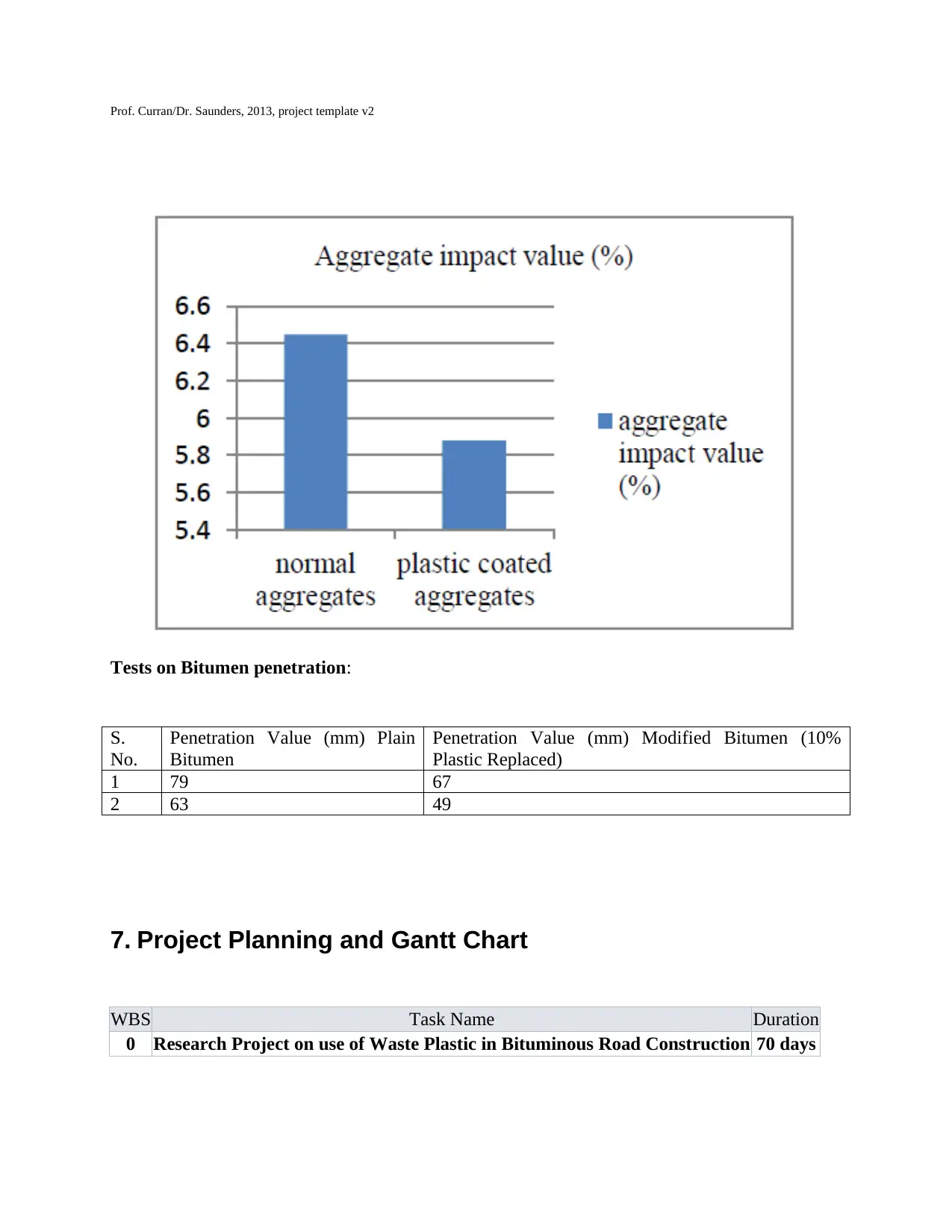
Prof. Curran/Dr. Saunders, 2013, project template v2
Tests on Bitumen penetration:
S.
No.
Penetration Value (mm) Plain
Bitumen
Penetration Value (mm) Modified Bitumen (10%
Plastic Replaced)
1 79 67
2 63 49
7. Project Planning and Gantt Chart
WBS Task Name Duration
0 Research Project on use of Waste Plastic in Bituminous Road Construction 70 days
Tests on Bitumen penetration:
S.
No.
Penetration Value (mm) Plain
Bitumen
Penetration Value (mm) Modified Bitumen (10%
Plastic Replaced)
1 79 67
2 63 49
7. Project Planning and Gantt Chart
WBS Task Name Duration
0 Research Project on use of Waste Plastic in Bituminous Road Construction 70 days
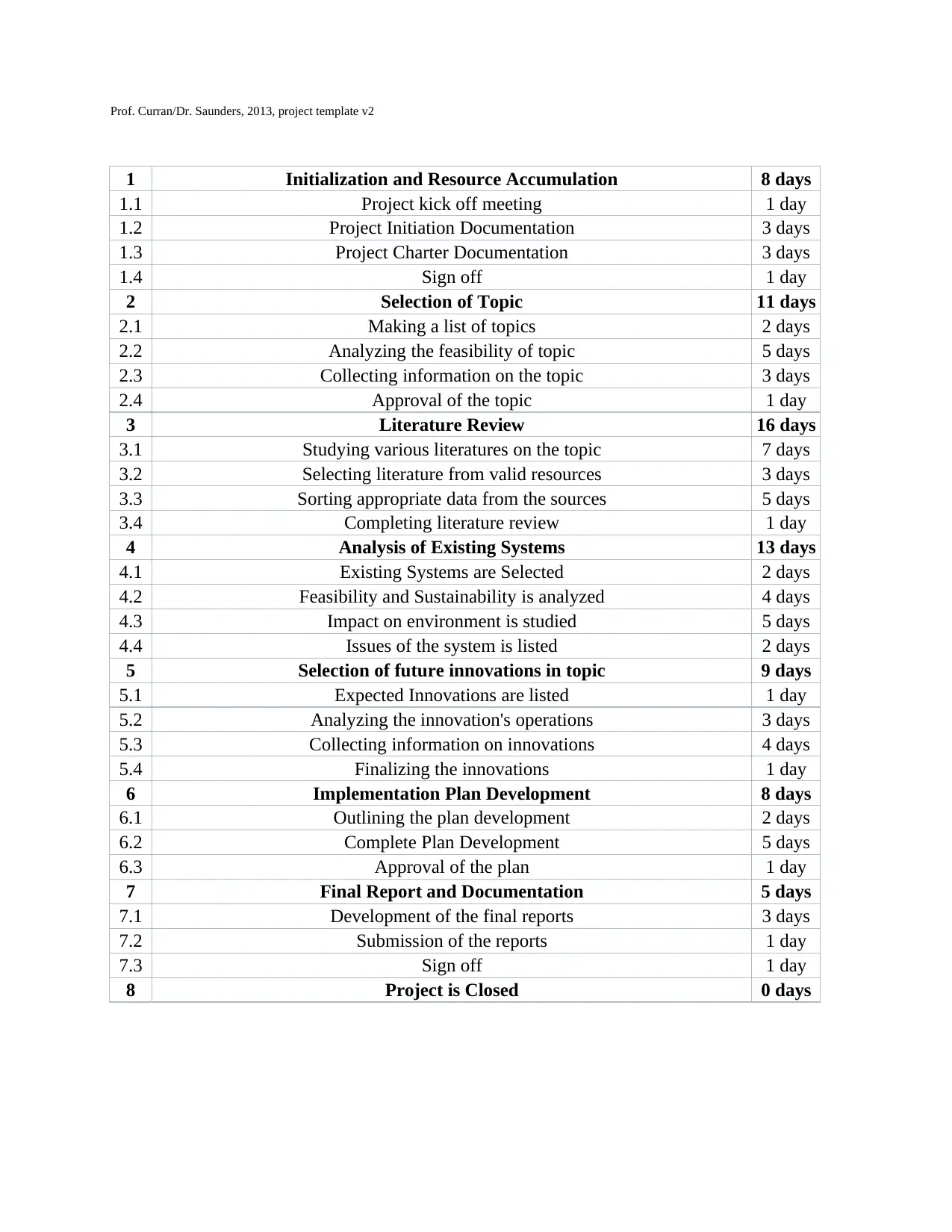
Prof. Curran/Dr. Saunders, 2013, project template v2
1 Initialization and Resource Accumulation 8 days
1.1 Project kick off meeting 1 day
1.2 Project Initiation Documentation 3 days
1.3 Project Charter Documentation 3 days
1.4 Sign off 1 day
2 Selection of Topic 11 days
2.1 Making a list of topics 2 days
2.2 Analyzing the feasibility of topic 5 days
2.3 Collecting information on the topic 3 days
2.4 Approval of the topic 1 day
3 Literature Review 16 days
3.1 Studying various literatures on the topic 7 days
3.2 Selecting literature from valid resources 3 days
3.3 Sorting appropriate data from the sources 5 days
3.4 Completing literature review 1 day
4 Analysis of Existing Systems 13 days
4.1 Existing Systems are Selected 2 days
4.2 Feasibility and Sustainability is analyzed 4 days
4.3 Impact on environment is studied 5 days
4.4 Issues of the system is listed 2 days
5 Selection of future innovations in topic 9 days
5.1 Expected Innovations are listed 1 day
5.2 Analyzing the innovation's operations 3 days
5.3 Collecting information on innovations 4 days
5.4 Finalizing the innovations 1 day
6 Implementation Plan Development 8 days
6.1 Outlining the plan development 2 days
6.2 Complete Plan Development 5 days
6.3 Approval of the plan 1 day
7 Final Report and Documentation 5 days
7.1 Development of the final reports 3 days
7.2 Submission of the reports 1 day
7.3 Sign off 1 day
8 Project is Closed 0 days
1 Initialization and Resource Accumulation 8 days
1.1 Project kick off meeting 1 day
1.2 Project Initiation Documentation 3 days
1.3 Project Charter Documentation 3 days
1.4 Sign off 1 day
2 Selection of Topic 11 days
2.1 Making a list of topics 2 days
2.2 Analyzing the feasibility of topic 5 days
2.3 Collecting information on the topic 3 days
2.4 Approval of the topic 1 day
3 Literature Review 16 days
3.1 Studying various literatures on the topic 7 days
3.2 Selecting literature from valid resources 3 days
3.3 Sorting appropriate data from the sources 5 days
3.4 Completing literature review 1 day
4 Analysis of Existing Systems 13 days
4.1 Existing Systems are Selected 2 days
4.2 Feasibility and Sustainability is analyzed 4 days
4.3 Impact on environment is studied 5 days
4.4 Issues of the system is listed 2 days
5 Selection of future innovations in topic 9 days
5.1 Expected Innovations are listed 1 day
5.2 Analyzing the innovation's operations 3 days
5.3 Collecting information on innovations 4 days
5.4 Finalizing the innovations 1 day
6 Implementation Plan Development 8 days
6.1 Outlining the plan development 2 days
6.2 Complete Plan Development 5 days
6.3 Approval of the plan 1 day
7 Final Report and Documentation 5 days
7.1 Development of the final reports 3 days
7.2 Submission of the reports 1 day
7.3 Sign off 1 day
8 Project is Closed 0 days
⊘ This is a preview!⊘
Do you want full access?
Subscribe today to unlock all pages.

Trusted by 1+ million students worldwide
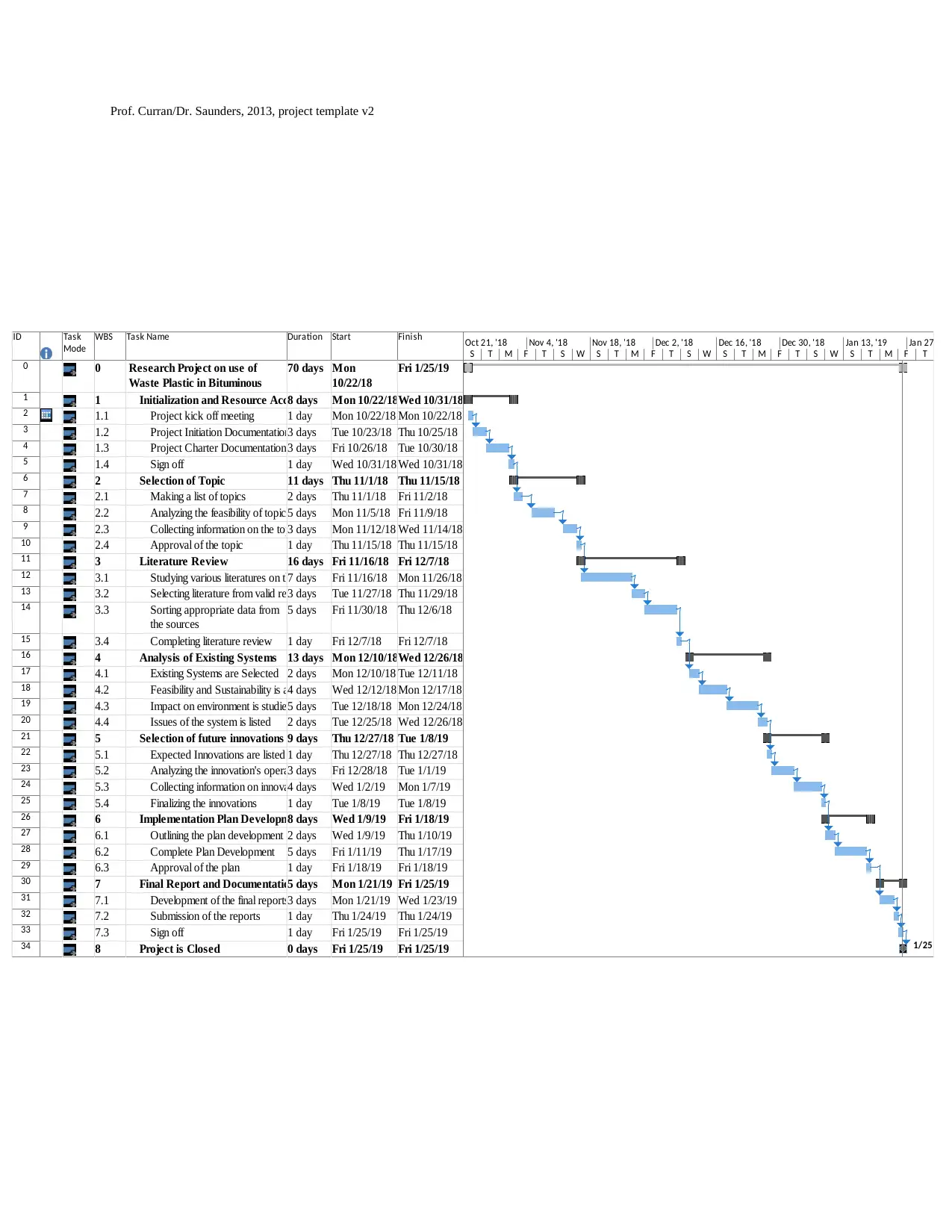
Prof. Curran/Dr. Saunders, 2013, project template v2
ID Task
Mode
WBS Task Name Duration Start Finish
0 0 Research Project on use of
Waste Plastic in Bituminous
Road Construction
70 days Mon
10/22/18
Fri 1/25/19
1 1 Initialization and Resource Accumulation8 days Mon 10/22/18Wed 10/31/18
2 1.1 Project kick off meeting 1 day Mon 10/22/18 Mon 10/22/18
3 1.2 Project Initiation Documentation3 days Tue 10/23/18 Thu 10/25/18
4 1.3 Project Charter Documentation3 days Fri 10/26/18 Tue 10/30/18
5 1.4 Sign off 1 day Wed 10/31/18 Wed 10/31/18
6 2 Selection of Topic 11 days Thu 11/1/18 Thu 11/15/18
7 2.1 Making a list of topics 2 days Thu 11/1/18 Fri 11/2/18
8 2.2 Analyzing the feasibility of topic 5 days Mon 11/5/18 Fri 11/9/18
9 2.3 Collecting information on the topic3 days Mon 11/12/18 Wed 11/14/18
10 2.4 Approval of the topic 1 day Thu 11/15/18 Thu 11/15/18
11 3 Literature Review 16 days Fri 11/16/18 Fri 12/7/18
12 3.1 Studying various literatures on the topic7 days Fri 11/16/18 Mon 11/26/18
13 3.2 Selecting literature from valid resources3 days Tue 11/27/18 Thu 11/29/18
14 3.3 Sorting appropriate data from
the sources
5 days Fri 11/30/18 Thu 12/6/18
15 3.4 Completing literature review 1 day Fri 12/7/18 Fri 12/7/18
16 4 Analysis of Existing Systems 13 days Mon 12/10/18Wed 12/26/18
17 4.1 Existing Systems are Selected 2 days Mon 12/10/18 Tue 12/11/18
18 4.2 Feasibility and Sustainability is analyzed4 days Wed 12/12/18 Mon 12/17/18
19 4.3 Impact on environment is studied5 days Tue 12/18/18 Mon 12/24/18
20 4.4 Issues of the system is listed 2 days Tue 12/25/18 Wed 12/26/18
21 5 Selection of future innovations in topic9 days Thu 12/27/18 Tue 1/8/19
22 5.1 Expected Innovations are listed 1 day Thu 12/27/18 Thu 12/27/18
23 5.2 Analyzing the innovation's operations3 days Fri 12/28/18 Tue 1/1/19
24 5.3 Collecting information on innovations4 days Wed 1/2/19 Mon 1/7/19
25 5.4 Finalizing the innovations 1 day Tue 1/8/19 Tue 1/8/19
26 6 Implementation Plan Development8 days Wed 1/9/19 Fri 1/18/19
27 6.1 Outlining the plan development 2 days Wed 1/9/19 Thu 1/10/19
28 6.2 Complete Plan Development 5 days Fri 1/11/19 Thu 1/17/19
29 6.3 Approval of the plan 1 day Fri 1/18/19 Fri 1/18/19
30 7 Final Report and Documentation5 days Mon 1/21/19 Fri 1/25/19
31 7.1 Development of the final reports3 days Mon 1/21/19 Wed 1/23/19
32 7.2 Submission of the reports 1 day Thu 1/24/19 Thu 1/24/19
33 7.3 Sign off 1 day Fri 1/25/19 Fri 1/25/19
34 8 Project is Closed 0 days Fri 1/25/19 Fri 1/25/19 1/25
S T M F T S W S T M F T S W S T M F T S W S T M F T
Oct 21, '18 Nov 4, '18 Nov 18, '18 Dec 2, '18 Dec 16, '18 Dec 30, '18 Jan 13, '19 Jan 27, '19
ID Task
Mode
WBS Task Name Duration Start Finish
0 0 Research Project on use of
Waste Plastic in Bituminous
Road Construction
70 days Mon
10/22/18
Fri 1/25/19
1 1 Initialization and Resource Accumulation8 days Mon 10/22/18Wed 10/31/18
2 1.1 Project kick off meeting 1 day Mon 10/22/18 Mon 10/22/18
3 1.2 Project Initiation Documentation3 days Tue 10/23/18 Thu 10/25/18
4 1.3 Project Charter Documentation3 days Fri 10/26/18 Tue 10/30/18
5 1.4 Sign off 1 day Wed 10/31/18 Wed 10/31/18
6 2 Selection of Topic 11 days Thu 11/1/18 Thu 11/15/18
7 2.1 Making a list of topics 2 days Thu 11/1/18 Fri 11/2/18
8 2.2 Analyzing the feasibility of topic 5 days Mon 11/5/18 Fri 11/9/18
9 2.3 Collecting information on the topic3 days Mon 11/12/18 Wed 11/14/18
10 2.4 Approval of the topic 1 day Thu 11/15/18 Thu 11/15/18
11 3 Literature Review 16 days Fri 11/16/18 Fri 12/7/18
12 3.1 Studying various literatures on the topic7 days Fri 11/16/18 Mon 11/26/18
13 3.2 Selecting literature from valid resources3 days Tue 11/27/18 Thu 11/29/18
14 3.3 Sorting appropriate data from
the sources
5 days Fri 11/30/18 Thu 12/6/18
15 3.4 Completing literature review 1 day Fri 12/7/18 Fri 12/7/18
16 4 Analysis of Existing Systems 13 days Mon 12/10/18Wed 12/26/18
17 4.1 Existing Systems are Selected 2 days Mon 12/10/18 Tue 12/11/18
18 4.2 Feasibility and Sustainability is analyzed4 days Wed 12/12/18 Mon 12/17/18
19 4.3 Impact on environment is studied5 days Tue 12/18/18 Mon 12/24/18
20 4.4 Issues of the system is listed 2 days Tue 12/25/18 Wed 12/26/18
21 5 Selection of future innovations in topic9 days Thu 12/27/18 Tue 1/8/19
22 5.1 Expected Innovations are listed 1 day Thu 12/27/18 Thu 12/27/18
23 5.2 Analyzing the innovation's operations3 days Fri 12/28/18 Tue 1/1/19
24 5.3 Collecting information on innovations4 days Wed 1/2/19 Mon 1/7/19
25 5.4 Finalizing the innovations 1 day Tue 1/8/19 Tue 1/8/19
26 6 Implementation Plan Development8 days Wed 1/9/19 Fri 1/18/19
27 6.1 Outlining the plan development 2 days Wed 1/9/19 Thu 1/10/19
28 6.2 Complete Plan Development 5 days Fri 1/11/19 Thu 1/17/19
29 6.3 Approval of the plan 1 day Fri 1/18/19 Fri 1/18/19
30 7 Final Report and Documentation5 days Mon 1/21/19 Fri 1/25/19
31 7.1 Development of the final reports3 days Mon 1/21/19 Wed 1/23/19
32 7.2 Submission of the reports 1 day Thu 1/24/19 Thu 1/24/19
33 7.3 Sign off 1 day Fri 1/25/19 Fri 1/25/19
34 8 Project is Closed 0 days Fri 1/25/19 Fri 1/25/19 1/25
S T M F T S W S T M F T S W S T M F T S W S T M F T
Oct 21, '18 Nov 4, '18 Nov 18, '18 Dec 2, '18 Dec 16, '18 Dec 30, '18 Jan 13, '19 Jan 27, '19
Paraphrase This Document
Need a fresh take? Get an instant paraphrase of this document with our AI Paraphraser

Prof. Curran/Dr. Saunders, 2013, project template v2
8. Conclusions
The assignment had been made on the topic of use of Waste Plastic in Bituminous Road
Construction. It had been defined that the plastic is a material comprising of one or more organic
polymer with huge molecular mass resulting in the formation of the finished state producing the
finer states and built against the natural process of degradation. The study helped in achieving the
objectives of execution of the soil test for identifying the percentage of plastic, designing the
pavements those are flexible in terms of environment protection and calculation the aggregate of
plastic and incorporate plastic using titanium-dioxide. Some other goals of the study included the
eradication of the potholes on the roads, increment of the lifespan of the roads, and controlling
the pollution due to the plastic wastages. The research was done on the secondary data analysis
by collecting collective data on the experiments and testing results on plastic contents in
bituminous roads had been analyzed and their data had been taken for consideration. The various
testing methods on soil aggregates for bitumen like Aggregate Testing, Abrasion Testing, Impact
Test, and Tests on Bitumen penetration were considered and secondary data on all those test
results were evaluated.
9. References
Batra, R.S.Y.R., 2016. AN INNOVATIVE TECHNIQUE FOR ROAD CONSTRUCTION BY
WASTE PLASTIC. Futuristic Trends in Engineering, Science, Humanities, and Technology
FTESHT-16, p.83.
Cardoso, R., Silva, R.V., de Brito, J. and Dhir, R., 2016. Use of recycled aggregates from
construction and demolition waste in geotechnical applications: A literature review. Waste
management, 49, pp.131-145.
Chakraborty, A. and Mehta, S., 2017. Utilization & Minimization Of Waste Plastic In
Construction Of Pavement: A Review. International Journal of Engineering Technology Science
and Research IJETSR www. ijetsr. com ISSN, pp.2394-3386.
Gautam, P.K., Kalla, P., Jethoo, A.S., Agrawal, R. and Singh, H., 2018. Sustainable use of waste
in flexible pavement: A review. Construction and Building Materials, 180, pp.239-253.
Jadon, R. and Kansal, R., 2016. Experimental Study onUse of Waste Plastic in Bituminous
Concrete Mix.
Jafar, J.J., 2016. Utilisation of waste plastic in bituminous mix for improved performance of
roads. KSCE Journal of Civil Engineering, 20(1), pp.243-249.
8. Conclusions
The assignment had been made on the topic of use of Waste Plastic in Bituminous Road
Construction. It had been defined that the plastic is a material comprising of one or more organic
polymer with huge molecular mass resulting in the formation of the finished state producing the
finer states and built against the natural process of degradation. The study helped in achieving the
objectives of execution of the soil test for identifying the percentage of plastic, designing the
pavements those are flexible in terms of environment protection and calculation the aggregate of
plastic and incorporate plastic using titanium-dioxide. Some other goals of the study included the
eradication of the potholes on the roads, increment of the lifespan of the roads, and controlling
the pollution due to the plastic wastages. The research was done on the secondary data analysis
by collecting collective data on the experiments and testing results on plastic contents in
bituminous roads had been analyzed and their data had been taken for consideration. The various
testing methods on soil aggregates for bitumen like Aggregate Testing, Abrasion Testing, Impact
Test, and Tests on Bitumen penetration were considered and secondary data on all those test
results were evaluated.
9. References
Batra, R.S.Y.R., 2016. AN INNOVATIVE TECHNIQUE FOR ROAD CONSTRUCTION BY
WASTE PLASTIC. Futuristic Trends in Engineering, Science, Humanities, and Technology
FTESHT-16, p.83.
Cardoso, R., Silva, R.V., de Brito, J. and Dhir, R., 2016. Use of recycled aggregates from
construction and demolition waste in geotechnical applications: A literature review. Waste
management, 49, pp.131-145.
Chakraborty, A. and Mehta, S., 2017. Utilization & Minimization Of Waste Plastic In
Construction Of Pavement: A Review. International Journal of Engineering Technology Science
and Research IJETSR www. ijetsr. com ISSN, pp.2394-3386.
Gautam, P.K., Kalla, P., Jethoo, A.S., Agrawal, R. and Singh, H., 2018. Sustainable use of waste
in flexible pavement: A review. Construction and Building Materials, 180, pp.239-253.
Jadon, R. and Kansal, R., 2016. Experimental Study onUse of Waste Plastic in Bituminous
Concrete Mix.
Jafar, J.J., 2016. Utilisation of waste plastic in bituminous mix for improved performance of
roads. KSCE Journal of Civil Engineering, 20(1), pp.243-249.
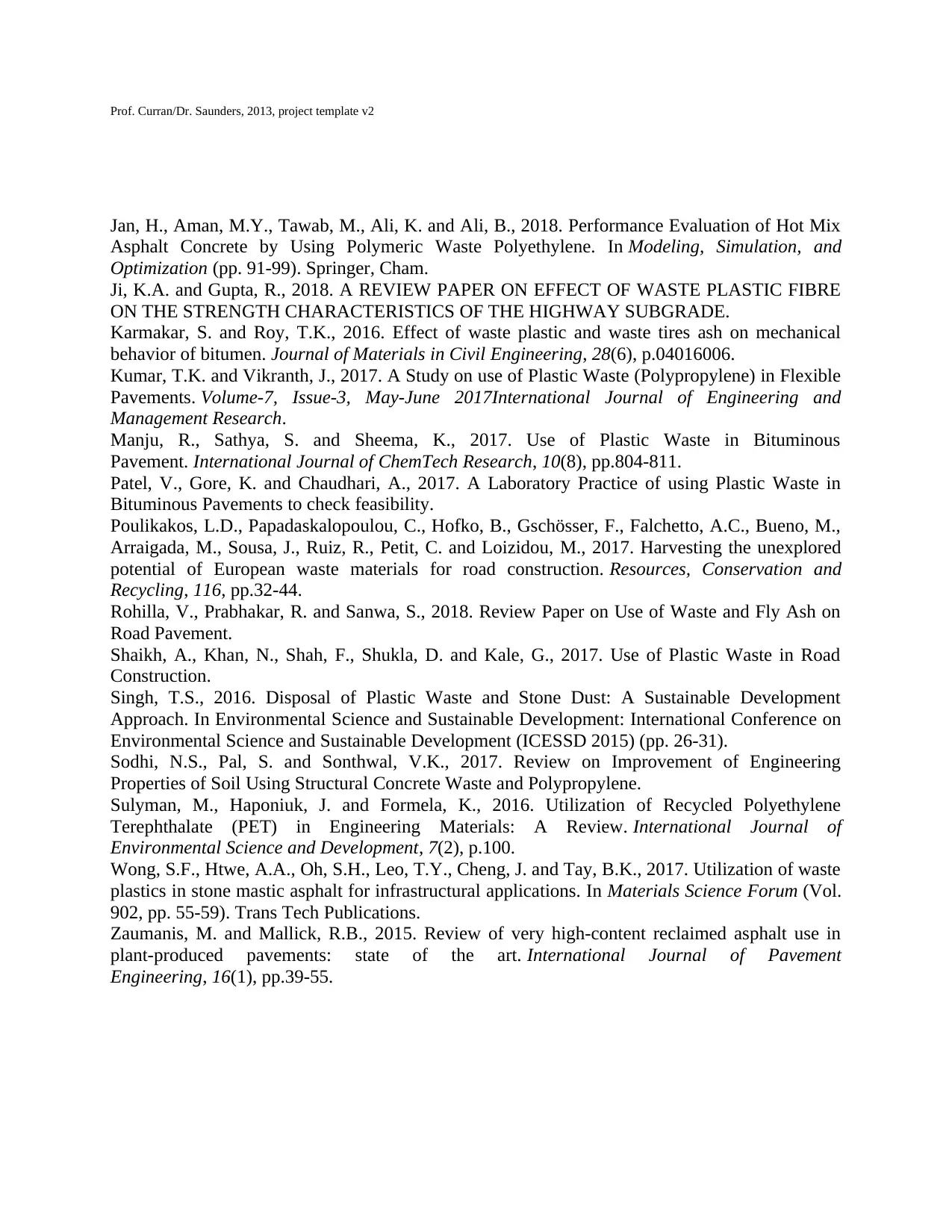
Prof. Curran/Dr. Saunders, 2013, project template v2
Jan, H., Aman, M.Y., Tawab, M., Ali, K. and Ali, B., 2018. Performance Evaluation of Hot Mix
Asphalt Concrete by Using Polymeric Waste Polyethylene. In Modeling, Simulation, and
Optimization (pp. 91-99). Springer, Cham.
Ji, K.A. and Gupta, R., 2018. A REVIEW PAPER ON EFFECT OF WASTE PLASTIC FIBRE
ON THE STRENGTH CHARACTERISTICS OF THE HIGHWAY SUBGRADE.
Karmakar, S. and Roy, T.K., 2016. Effect of waste plastic and waste tires ash on mechanical
behavior of bitumen. Journal of Materials in Civil Engineering, 28(6), p.04016006.
Kumar, T.K. and Vikranth, J., 2017. A Study on use of Plastic Waste (Polypropylene) in Flexible
Pavements. Volume-7, Issue-3, May-June 2017International Journal of Engineering and
Management Research.
Manju, R., Sathya, S. and Sheema, K., 2017. Use of Plastic Waste in Bituminous
Pavement. International Journal of ChemTech Research, 10(8), pp.804-811.
Patel, V., Gore, K. and Chaudhari, A., 2017. A Laboratory Practice of using Plastic Waste in
Bituminous Pavements to check feasibility.
Poulikakos, L.D., Papadaskalopoulou, C., Hofko, B., Gschösser, F., Falchetto, A.C., Bueno, M.,
Arraigada, M., Sousa, J., Ruiz, R., Petit, C. and Loizidou, M., 2017. Harvesting the unexplored
potential of European waste materials for road construction. Resources, Conservation and
Recycling, 116, pp.32-44.
Rohilla, V., Prabhakar, R. and Sanwa, S., 2018. Review Paper on Use of Waste and Fly Ash on
Road Pavement.
Shaikh, A., Khan, N., Shah, F., Shukla, D. and Kale, G., 2017. Use of Plastic Waste in Road
Construction.
Singh, T.S., 2016. Disposal of Plastic Waste and Stone Dust: A Sustainable Development
Approach. In Environmental Science and Sustainable Development: International Conference on
Environmental Science and Sustainable Development (ICESSD 2015) (pp. 26-31).
Sodhi, N.S., Pal, S. and Sonthwal, V.K., 2017. Review on Improvement of Engineering
Properties of Soil Using Structural Concrete Waste and Polypropylene.
Sulyman, M., Haponiuk, J. and Formela, K., 2016. Utilization of Recycled Polyethylene
Terephthalate (PET) in Engineering Materials: A Review. International Journal of
Environmental Science and Development, 7(2), p.100.
Wong, S.F., Htwe, A.A., Oh, S.H., Leo, T.Y., Cheng, J. and Tay, B.K., 2017. Utilization of waste
plastics in stone mastic asphalt for infrastructural applications. In Materials Science Forum (Vol.
902, pp. 55-59). Trans Tech Publications.
Zaumanis, M. and Mallick, R.B., 2015. Review of very high-content reclaimed asphalt use in
plant-produced pavements: state of the art. International Journal of Pavement
Engineering, 16(1), pp.39-55.
Jan, H., Aman, M.Y., Tawab, M., Ali, K. and Ali, B., 2018. Performance Evaluation of Hot Mix
Asphalt Concrete by Using Polymeric Waste Polyethylene. In Modeling, Simulation, and
Optimization (pp. 91-99). Springer, Cham.
Ji, K.A. and Gupta, R., 2018. A REVIEW PAPER ON EFFECT OF WASTE PLASTIC FIBRE
ON THE STRENGTH CHARACTERISTICS OF THE HIGHWAY SUBGRADE.
Karmakar, S. and Roy, T.K., 2016. Effect of waste plastic and waste tires ash on mechanical
behavior of bitumen. Journal of Materials in Civil Engineering, 28(6), p.04016006.
Kumar, T.K. and Vikranth, J., 2017. A Study on use of Plastic Waste (Polypropylene) in Flexible
Pavements. Volume-7, Issue-3, May-June 2017International Journal of Engineering and
Management Research.
Manju, R., Sathya, S. and Sheema, K., 2017. Use of Plastic Waste in Bituminous
Pavement. International Journal of ChemTech Research, 10(8), pp.804-811.
Patel, V., Gore, K. and Chaudhari, A., 2017. A Laboratory Practice of using Plastic Waste in
Bituminous Pavements to check feasibility.
Poulikakos, L.D., Papadaskalopoulou, C., Hofko, B., Gschösser, F., Falchetto, A.C., Bueno, M.,
Arraigada, M., Sousa, J., Ruiz, R., Petit, C. and Loizidou, M., 2017. Harvesting the unexplored
potential of European waste materials for road construction. Resources, Conservation and
Recycling, 116, pp.32-44.
Rohilla, V., Prabhakar, R. and Sanwa, S., 2018. Review Paper on Use of Waste and Fly Ash on
Road Pavement.
Shaikh, A., Khan, N., Shah, F., Shukla, D. and Kale, G., 2017. Use of Plastic Waste in Road
Construction.
Singh, T.S., 2016. Disposal of Plastic Waste and Stone Dust: A Sustainable Development
Approach. In Environmental Science and Sustainable Development: International Conference on
Environmental Science and Sustainable Development (ICESSD 2015) (pp. 26-31).
Sodhi, N.S., Pal, S. and Sonthwal, V.K., 2017. Review on Improvement of Engineering
Properties of Soil Using Structural Concrete Waste and Polypropylene.
Sulyman, M., Haponiuk, J. and Formela, K., 2016. Utilization of Recycled Polyethylene
Terephthalate (PET) in Engineering Materials: A Review. International Journal of
Environmental Science and Development, 7(2), p.100.
Wong, S.F., Htwe, A.A., Oh, S.H., Leo, T.Y., Cheng, J. and Tay, B.K., 2017. Utilization of waste
plastics in stone mastic asphalt for infrastructural applications. In Materials Science Forum (Vol.
902, pp. 55-59). Trans Tech Publications.
Zaumanis, M. and Mallick, R.B., 2015. Review of very high-content reclaimed asphalt use in
plant-produced pavements: state of the art. International Journal of Pavement
Engineering, 16(1), pp.39-55.
⊘ This is a preview!⊘
Do you want full access?
Subscribe today to unlock all pages.

Trusted by 1+ million students worldwide
1 out of 12
Your All-in-One AI-Powered Toolkit for Academic Success.
+13062052269
info@desklib.com
Available 24*7 on WhatsApp / Email
![[object Object]](/_next/static/media/star-bottom.7253800d.svg)
Unlock your academic potential
Copyright © 2020–2026 A2Z Services. All Rights Reserved. Developed and managed by ZUCOL.